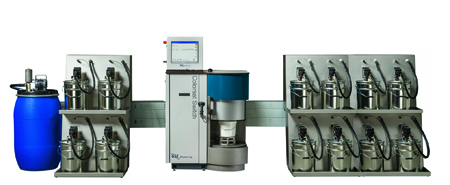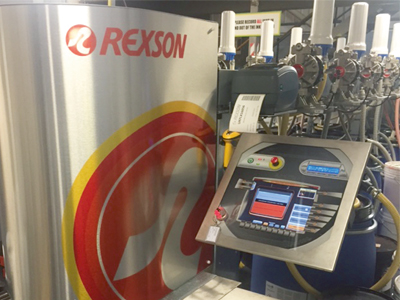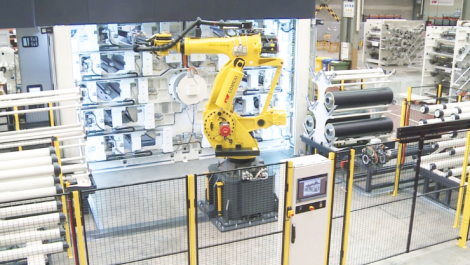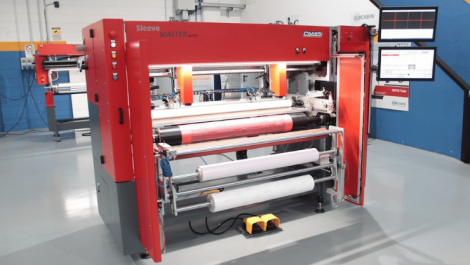A Rexson colorpoint IP system has been installed at Atlas Packaging
Shorter production runs, high running costs and stringent quality demands are driving flexo printers to take greater control of their processes. An integrated ink logistics programme is a sure way to slim down a flexo operation, saving resources, time and money. By Michal Lodej.
Huge benefits are available to a printer who can implement an ink dispensing system that includes colour management, proofing and integrated software. Not only are costs of materials, downtime, labour and stockholding reduced, but the printer is better placed to meet brand owners’ expectations in terms of colour consistency, flexibility and traceability.
Lean in
Maarten Hummelen, marketing director of GSE Dispensing, stated, ‘There are four elements of ink logistics where control is necessary in order to effectively eliminate waste from the process: ink management, colour management, proofing the inks and process integration.’
Ink management
A dispenser doses the exact ink quality and volume by calculating and mixing the recipe from barrels of base inks and varnishes. The operator enters the target colour and volume requirements into the interface; a computer calculates dosage volumes and activates the process. Press returns from previous jobs can be reused in new recipes. Modular dispensing systems are available with a wide range of base components to meet all ink volume requirements, from labels through to flexible and corrugated board printing.
Dispensing systems deliver a number of benefits. First, ink usage is reduced by dispensing exactly what is needed instead of ordering excess amounts of ready-mixed ink from the supplier to avert the risk of shortfalls.
Easy retrieval is a second important benefit. As the dispensing software provides a system for methodically storing ink, any inks can be registered on the dispenser’s stock system and barcoded, then easily located from stock for use in another job.
Thirdly, on occasions when excess ink remains after production, press return inks are easily recycled, quickly, in new recipes. Other benefits include lower ink costs, as base components are cheaper than ready-mixed inks, and reduced stockholding, resulting from more efficient ink usage.
Colour management
Recipes are the basis of ink management, but dispensing the right recipe does not always mean that the colour is right. For quality assurance purposes, photo-spectrometers are used to measure the accuracy of the dispensed colour.
Colour formulation software in combination with an ink dispenser with ink management software can improve the process of correcting colours at the press. This can be a one-time bucket adjustment or a recipe correction. Correcting the recipe is a permanent, ‘future proof’ solution. Adjusting the bucket is a temporary solution to compensate press circumstances that normally do not appear, such as substrate colour deviations.
If bucket adjustments are not archived, the return inks are not recyclable into new ink batches. To adjust colour at the press, one should therefore always measure the ink weight to achieve the right colour before putting it in the press, and process this adjustment in the ink management software.
The recipe changing process can be supported by a proofer and ink formulation software. One takes the proof, measures the colour using CIELab coordinates, and if the colours fall outside the required Delta E parameters, the software makes a suggestion to correct the recipe. The new recipe is imported to the ink management software, and dispensing occurs again. The colour is measured and if correct, the adjusted recipe is stored and the job goes to press.
Proofing the inks
A wet-proofing system measures a flexo ink’s colour at the same dot gain as it will experience on the press. This provides precise colour predictability, without fingerprinting, and without the need for colour adjustments during job changes at the target press. Without spending money on a new press, an ink proofing system normally adds thousands of euros of new press time to an average flexo plant.
Process integration
The above processes can be integrated. For example, ink management software can be integrated with all commonly used colour formulation software solutions for packaging and label printers. Ink management software can also be integrated with ERP/MIS software packages, providing significant process improvements. Order data has to be keyed in only once and real-time information about recipe availability after the corrected recipe has been stored enables Quick Response Manufacturing.

Coloursat Switch from GSE Dispensing connects to buckets on waterfall frames or high volume containers
What’s available?
German manufacturer, Füll Dispensing Systems has a range of systems available from simple operating equipment, such as agitators, to fully automated processes.
The dispensing process is divided into up to three steps: coarse dispensing, (highest throughput, lowest accuracy), mean dispensing (medium throughput, medium accuracy) and fine dispensing (very low throughput for highest dispensing accuracy).
In a standard configuration, the customer connects an interchangeable barrel to the storage system via a short hose connection in order to reduce vibration during operation. Vibration is also reduced by a pulsation damper in the feeding line to reduce pumping induced pressure peaks, which helps to give a constant dispensing jet. The system uses closed-loop gravimetric dispensing, with the dispensing valve controlled by the way the weight on the scale changes.
Each basic system can be modified and adapted to meet the specific needs of each client, designed and built considering consumption rates, delivery quantities, the media involved, local circumstances and further requirements.
Managing ink and colour has traditionally been an obstacle to achieving a lean process, not least because colour adjustments on press can account for up to half of set-up times, and incur substantial material waste.
The Italian company Inkmaker has introduced GT36, a system equipped with a maximum of 36 centre point dispensing high precision valves. The system can use up to four valves dispensing the same product simultaneously when handling bulk components.
Under the dispensing head containers of different sizes can be accommodated, allowing both pail as well as drum production. Another feature is the multi-flow, high accuracy dispensing valves mounted on the GT36, which can achieve an accuracy of up to 0.1 grammes.
The Autoblend version of Rexson’s ColorPoint IP ink dispensing unit features a transfer system that moves the ink bucket from the dispense station automatically to the mixing station, whilst also cleaning the dispense valve head.
The mixing station will not only mix the ink bucket, but it will also clean itself immediately afterwards. The Autoblend solution means no operator interventions in the production of ink blends other than placing a lid on the bucket and delivering it to the press.
The system also features a scale that slides in and out of the dispense position to enable any manual additions to be made to the ink blends so these are also controlled and recorded. The ColorPoint operator interface records the action of each operator and sets the security levels automatically by means of a unique ID key system.
The Autoblend is complemented by the fully comprehensive management software package (ColorPoint Manager) that allows for full tracking and reporting of ink room activities, for traceability and costing purposes. ColorPoint Manager also interfaces with customers’ spectrophotometers and business management systems.
On a printing floor, with today’s short runs and frequent colour changes, the benefit of an organised ink kitchen is almost a precondition to achieving profitability. Yet dispensing solutions alone are not enough; discipline and organisation of the work floor must be considered as printers are fighting to increase production, reduce costs and waste while keeping prices competitive without compromising on quality.






